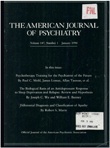DSM-III psychiatric disorders among Hmong refugees in the United States: a point prevalence study
Abstract
The author reports on a survey of 97 Hmong adult refugees in the United States. Thirty of these refugees showed symptoms of chronic maladjustment, and 13 showed another DSM-III axis I disorder; two manifested a paranoid psychosis, and six had a major depression. There were few axis II diagnoses. Medical conditions were frequent and often psychophysiological in nature, but they were not associated with axis I disorders. Axis IV psychosocial stressors were not associated with axis I diagnoses, but subjects with an axis I disorder tended to show lower adaptive levels on axis V. The demographic condition most strongly associated with an axis I diagnosis was current status as a welfare recipient.
Access content
To read the fulltext, please use one of the options below to sign in or purchase access.- Personal login
- Institutional Login
- Sign in via OpenAthens
- Register for access
-
Please login/register if you wish to pair your device and check access availability.
Not a subscriber?
PsychiatryOnline subscription options offer access to the DSM-5 library, books, journals, CME, and patient resources. This all-in-one virtual library provides psychiatrists and mental health professionals with key resources for diagnosis, treatment, research, and professional development.
Need more help? PsychiatryOnline Customer Service may be reached by emailing [email protected] or by calling 800-368-5777 (in the U.S.) or 703-907-7322 (outside the U.S.).



